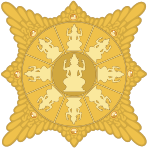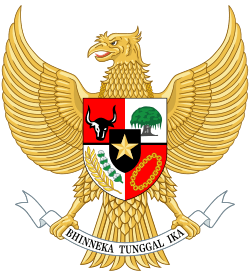Investigating Committee for Preparatory Work for Independence
The Investigating Committee for Preparatory Work for Independence (Indonesian: Badan Penyelidik Usaha-usaha Persiapan Kemerdekaan, BPUPK) (Japanese: 独立準備調査会, Hepburn: Dokuritsu Junbi Chōsa-kai, Nihon-shiki/Kunrei-shiki: Dokuritu Zyunbi Tyoosa-kai), sometimes referred to as the Investigating Committee for Preparatory Work for Indonesian Independence (Indonesian: Badan Penyelidik Usaha-usaha Persiapan Kemerdekaan Indonesia (BPUPKI)),[note 1] was an organization set up in March 1945 by the Japanese military authority in Java during the Japanese occupation of Indonesia as the initial stage of the establishment of independence for the area under the control of the Japanese 16th Army. The BPUPK held two plenary meetings; the first was from 29 May to 1 June 1945 and the second was between 10 and 17 July 1945.
Background
Realising Japan was losing the war, on 7 September 1944, the Japanese Prime Minister Kuniaki Koiso promised "future independence for the Dutch East Indies", without specifying the exact extent of the nation to be established.[1] The Japanese navy was not supportive of the idea, but the 25th Army in Sumatra established a Central Advisory Board, headed by Mohammad Sjafei, which met only once. Despite navy opposition, army-navy liaison vice-admiral Maeda Tadashi began to fund speaking tours by Indonesian nationalists Sukarno and Hatta. Other groups were set up, both civilian and military, and Indonesians began to be appointed to administrative posts. After the Japanese defeat at the Battle of Leyte Gulf and the liberation of the Philippines, the Japanese abandoned hope of turning Indonesia into a puppet state, and now began to try and win goodwill. However, a rebellion by PETA militas in Blitar in February 1945 showed the Japanese they were losing control.[2][3]
Formation and composition
The BPUPK was announced by the 16th Army on 1 March 1945 to work on "preparations for independence in the region of the government of this island of Java".[4] In the three months before the committee was established, a 19-member advisory board, or Sanyo Kaigi chaired by Sartono discussed the organization, agenda and membership of it. The membership was to comprise 30 Indonesians, 3 Japanese and one representative each of the Chinese, Arab and Dutch ethnic groups. The board agreed to the two-stage Japanese plan of an investigating committee for Java, followed by a preparation committee for all of Indonesia. It also agreed that the territory of the independent state would not be discussed[5] The BPUPK eventually met in the building formerly used by the Volksraad (People's Council), which had been set up by the Dutch. The Japanese appointed 59 members, representing the major groups in Java and Madura. The membership included eight Japanese, including one of the vice-chairmen. Among the members were:[2]
- Dr. Radjiman Wediodiningrat (chairman)
- Ichibangase Yoshio (vice-chairman)
- Suroso (vice-chairman)
- Abdul Gafar Pringgodigdo (co-secretary)
- Sukarno
- Mohammad Hatta
- Besar Mertokusumo
- Mansur
- Dewantara
- Agus Salim
- Soepomo
- M. Soetardjo Kartohadikoesorno
- Sumitro Djojohadikusumo
- Abikoesno Tjokrosoejoso
- Bagus Hadikusuma
- Abdul Wahid Hasyim
- Muhammad Yamin
- Abdurrahman Baswedan
- Agus Muhsin Dasaad
- Parada Harahap
- Liem Koen Hian
- Oey Tiang Tjoei
- Oei Tjong Hauw
- Tan Eng Hoa
- P. F. Dahler
The other co-secretary was a Japanese, Ichibangase Yoshio (一番ヶ背 芳雄), who was unable to understand Indonesian, the language used in the meetings.[3]
On 25 July, a similar organization was set up by the Japanese 25th Army, in Sumatra, with Mohammad Sjafei as chairman. In eastern Indonesian, the Japanese Navy, the occupying authority, allowed the establishment of a short-lived and impotent National Party chaired by the Sultan of Bone, but it was banned six weeks later.[6]
Plenary meetings
First (29 May – 1 June 1945)
The first session consisted mostly of speeches by members and discussions about the ideology of an independent state, in particular whether there would be a role for Islam. It opened with a speech by the commander of the Japanese 16th Army, who said that independence was being granted to Indonesia to ensure good relations with Japan in the long term.[7] On 31 May, Professor Soepomo called for an authoritarian integralistic state based on a combination of the systems in Nazi Germany and Imperial Japan, with a strong executive. He claimed that as each individual would be a part of the state, there would be no need for guarantees of human rights because the interests of the state and its citizens would be exactly the same.[8] On the final day, 1 June, Sukarno made his famous speech in which he outlined the Pancasila - the five principles that would form the ideological basis of the new state. Although the speech was well-received, Islamic leaders were worried that their interests would not be protected under Pancasila.[9] At the end of the BPUPK session, members were encouraged to discuss their views and hear opinions from the people at meetings held in their hometowns. A sub-committee of eight members, the panitia kecil (small committee), was set up with Sukarno as chairman to discuss the issues that had emerged.[7][10]
Recess
During the recess, 38 members of the BPUPK met and, prompted by Sukarno, established a nine-member committee, the panitia sembilan, to work on a draft constitution. This group included nationalists as well as Islamic figures, and on 22 June produced a draft preamble to the constitution including the wording of Pancasila, albeit in a different order from that in Sukarno's 1 June speech, with the religious obligation for Muslims. This was mostly the work of Muhammad Yamin, who named the resultant document the Jakarta Charter.[9][11]
Second (10–17 July 1945)
This session debated and reached agreement on fundamental issues relating to the new nation, including its form, territory and constitution.[7] A large majority of members voted for independent Indonesia being a republic, rather than a monarchy or other type of state. By a vote of approximately two-thirds, it was decided that the territory of Indonesia would include not only the Dutch East Indies, but also Malaya, North Borneo, Portuguese Timor and West Papua, a concept known as Indonesia Raya (Great Indonesia), which was strongly supported by Mohammad Yamin.[12]
The debate about the nature of the state continued. The main opposition to Soepomo's integralistic concept came from Muhammad Yamin, who favoured a liberal democracy similar to the United States, with separation of powers and a bill of rights. Other delegates called for an Islamic state, or at the very least, a constitutional obligation for Muslims to abide by Shariah law.[13]
The constitution sub-committee held meetings on 11, 13 and 15 July to discuss details. All 27 members agreed to the final format on 15 July.[14] As Soepomo played a dominant role in the drafting of the document, his views were manifested in its provision for a strong state.[15]
Note
- "Indonesia" was not part of the name as the 16th Army only had authority over Java (Kusuma & Elson (2011), p. 196)
References
- Inomata 1952, p. 100.
- Ricklefs 2008, p. 339.
- Kahin 1952, p. 121.
- Kusuma & Elson 2011, p. 196.
- Inomata 1952, p. 102-104.
- Kahin 1952, p. 121-122.
- Inomata 1952, p. 106.
- Butt & Lindsey 2012, p. 40-41.
- Nasution 1995, p. 11.
- Elson 2009, p. 112.
- Elson 2009, p. 112-113.
- Inomata 1952, p. 107.
- Butt & Lindsey 2012, p. 42.
- Soeripto 1962, p. 80-131.
- Butt & Lindsey 2012, p. 41.
Works cited
- Butt, Simon; Lindsey, Tim (2012). The Constitution of Indonesia: A Contextual Analysis. Oxford & Portland, Oregon: Hart Publishing. ISBN 978-1-84113-018-7.CS1 maint: ref=harv (link)
- Elson, R. E. (October 2009). "Another Look at the Jakarta Charter Controversy of 1945" (PDF). Indonesia. 88 (88): 105–130. Retrieved 21 December 2018.
- Inomata, Aiko Kurasawa (1997). "Indonesia Merdeka Selekas-lekasnya: Preparations for Independence in the Last Days of Japanese Occupation". In Abdullah, Taufik (ed.). The Heartbeat of Indonesian Revolution. PT Gramedia Pustaka Utama. pp. 97–113. ISBN 978-979-605-723-8.CS1 maint: ref=harv (link)
- Kahin, George McTurnan (1961) [1952]. Nationalism and Revolution in Indonesia. Ithaca, New York: Cornell University Press.CS1 maint: ref=harv (link)
- Kusuma, A.B.; Elson, R.E. (2011), "A note on the sources for the 1945 constitutional debates in Indonesia" (PDF), Bijdragen tot de Taal-, Land- en Volkenkunde, 167 (2–3): 196–209, doi:10.1163/22134379-90003589, ISSN 0006-2294CS1 maint: ref=harv (link)
- Nasution, Adnan Buyung (1995), Aspirasi Pemerintahan Konstitutional di Indonesia: Studi Sosio-Legal atas Konstituante 1956-1956 (The Aspiration for Constitutional Government in Indonesia: A Socio-Legal Study of the Indonesian Konstituante 1956-1959) (in Indonesian), Jakarta: Pustaka Utama Grafiti, ISBN 978-979-444-384-2CS1 maint: ref=harv (link)
- Ricklefs, M.C. (2008) [1981]. A History of Modern Indonesia Since c.1300 (4th ed.). London: MacMillan. ISBN 978-0-230-54685-1.CS1 maint: ref=harv (link)
- Soeripto (Ed)) (1962), Lahirnya Undang-Undang Dasar 1945 (Birth of the 1945 Constitution) (in Indonesian), Surabaya: Penerbitan GripCS1 maint: ref=harv (link)


